Abstract
Complement component C9 binds to C5b-8 sites on target cells and polymerizes to form the membrane attack complex (MAC). The aim of the work reported here was to discover which region within C9 was responsible for protecting the globular protein against self-polymerization. Computer prediction modelling highlighted the domain at the N-terminus of C9, which was then investigated by site-directed mutagenesis. The mutated proteins were expressed using insect cells infected with baculovirus. Removal of 16, 20 or 23 amino acids at the N-terminus of C9 resulted in inactivation due to self-polymerization. In contrast, removal of 4, 8 or 12 amino acids resulted in a C9 that did not polymerize spontaneously, had two to threefold enhanced lytic activity on erythrocytes, and had increased binding to C5b-8 sites on rat neutrophils. These results suggest that the domain within the first 16 amino acids at the N-terminus of C9 is crucial in preventing the self-polymerization of the globular protein. We have also found that C9 contains a motif (27WSEWS31) common to a family of cytokine receptors that is similar to a tryptophan-rich motif (WEWWR) of the membrane pore formers, thiol-activated cytolysins. Mutation of this motif in C9 resulted in polymerized protein, consistent with this site keeping the N-terminus in a protected conformation and preventing premature self-polymerization.
Full text
PDF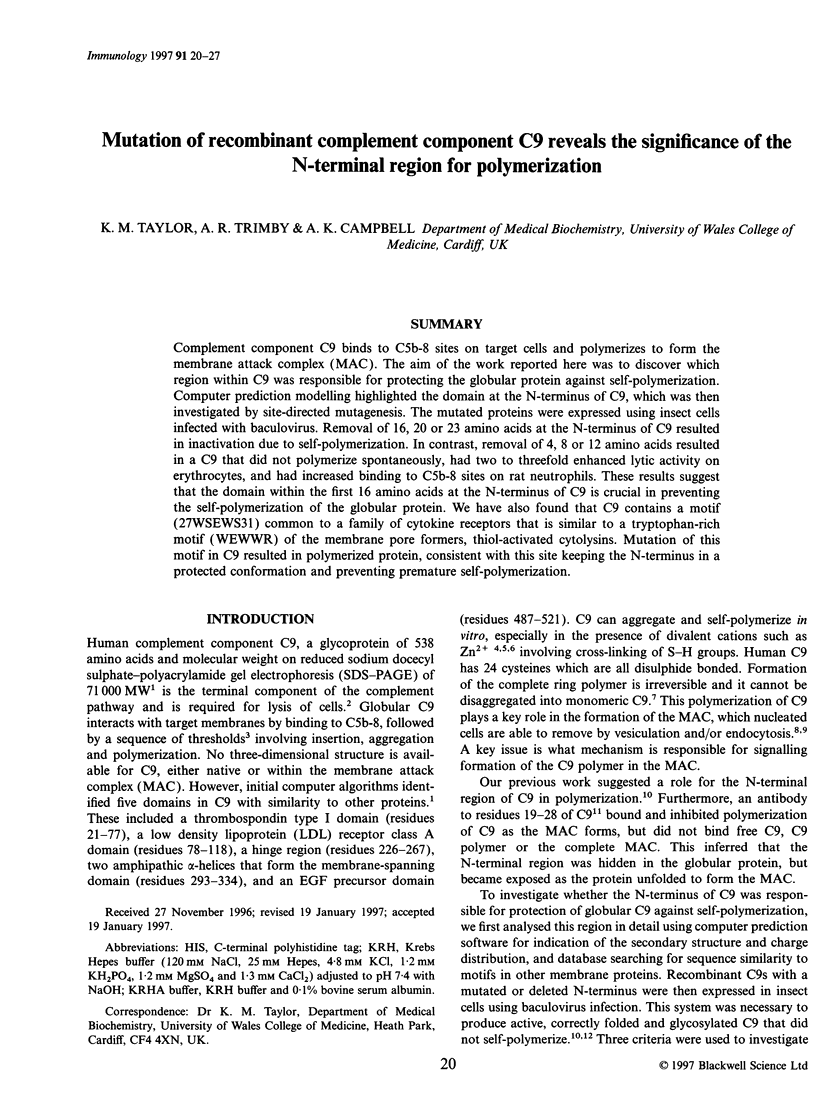
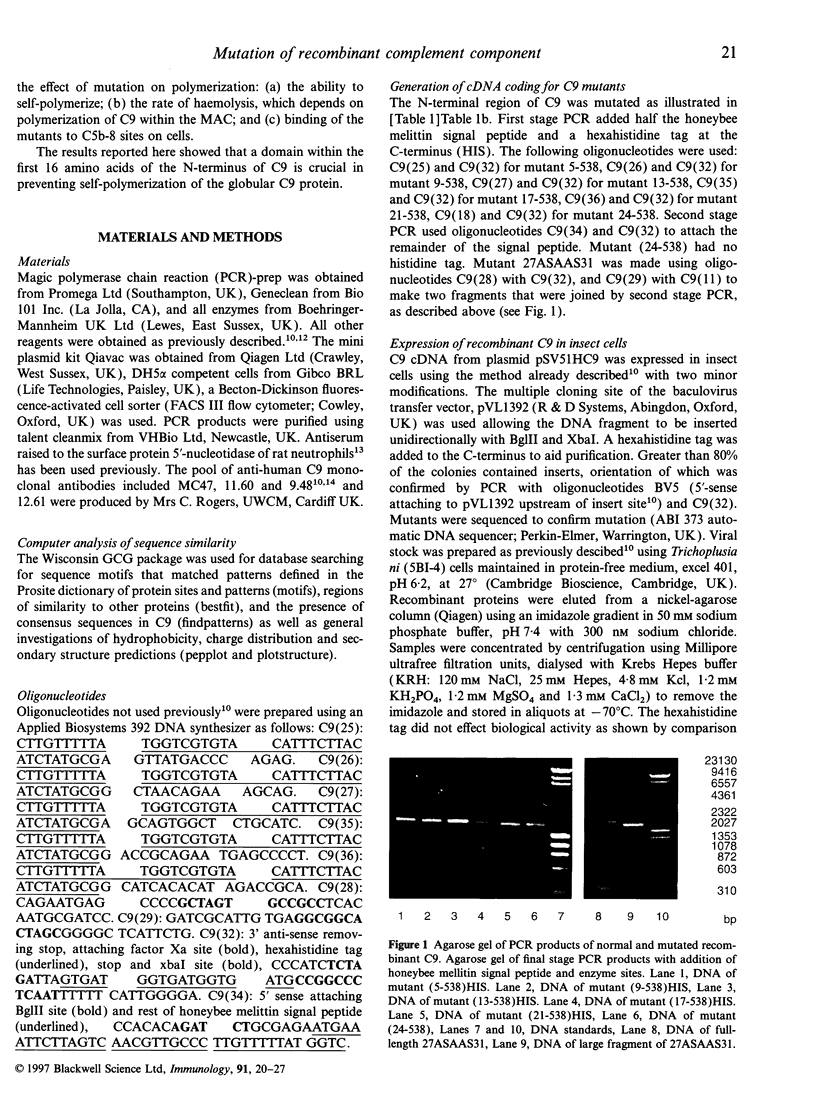
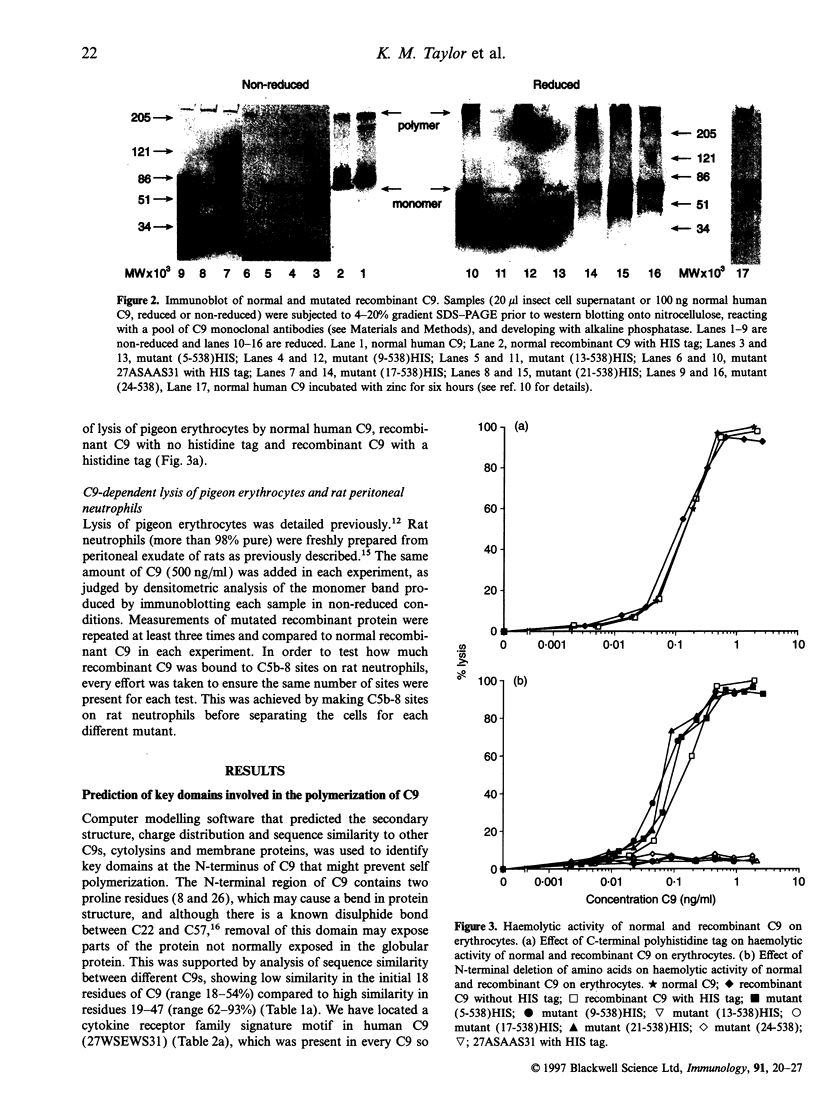
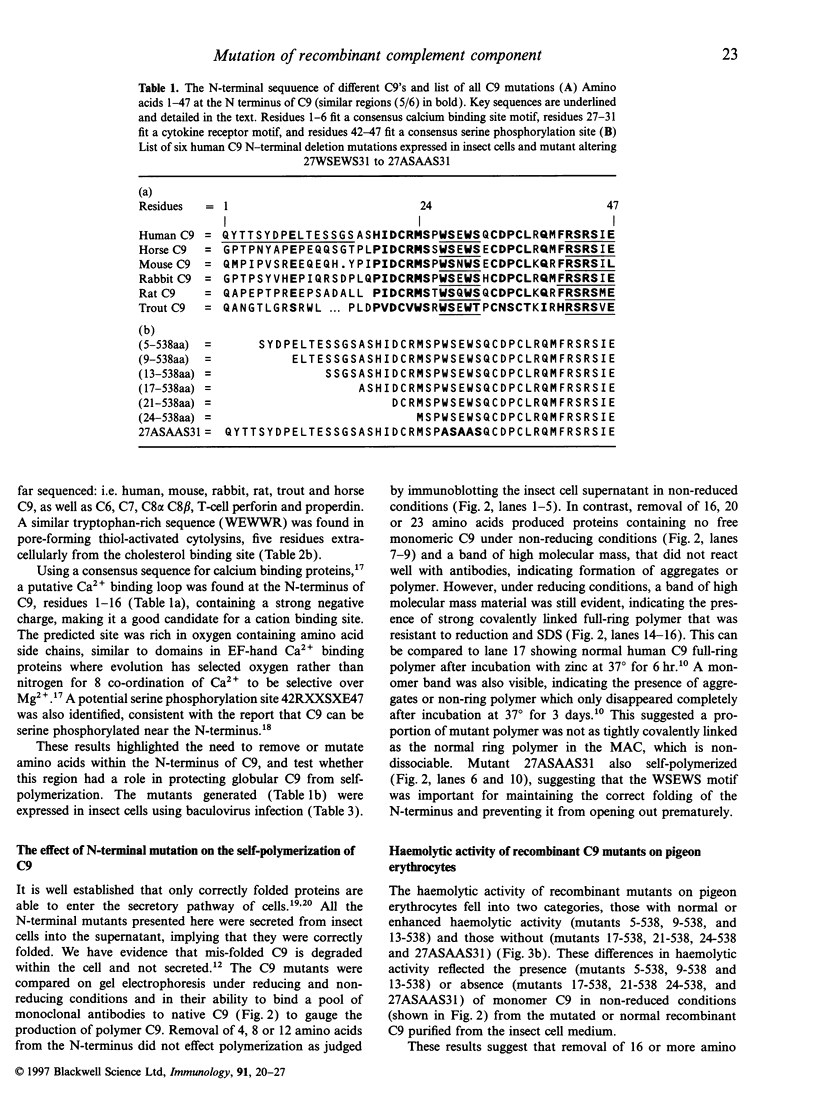
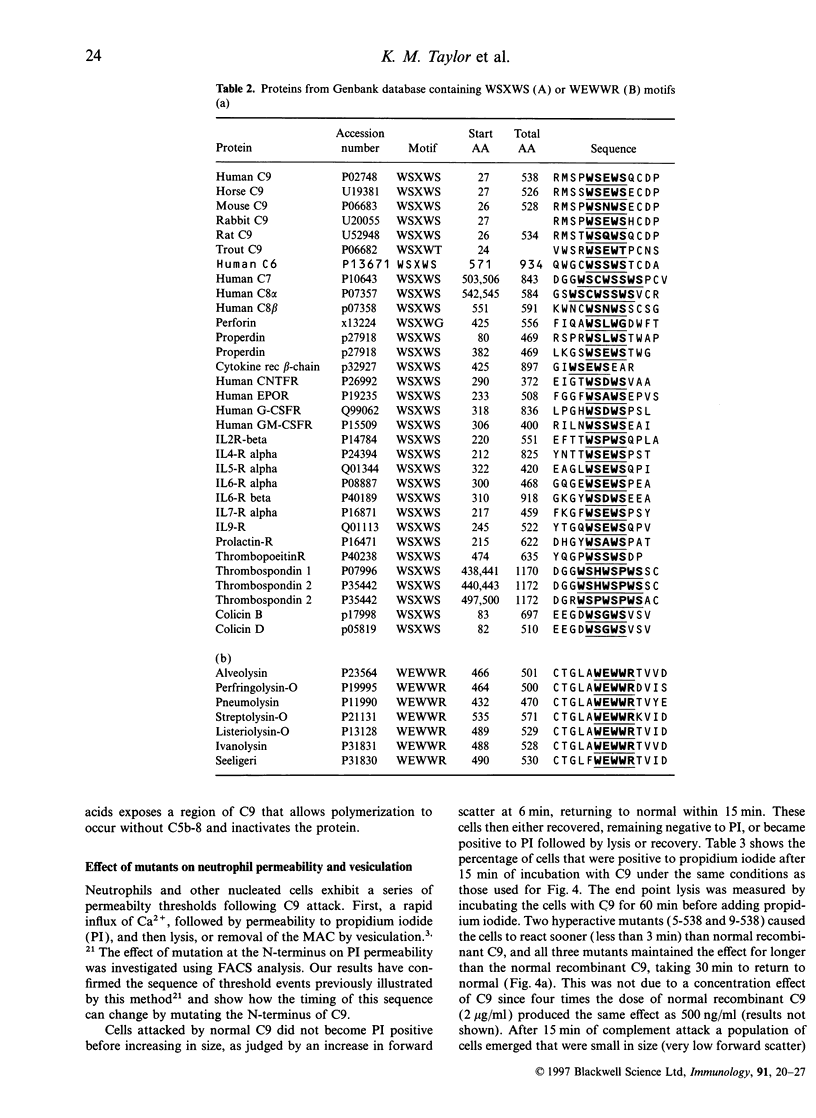
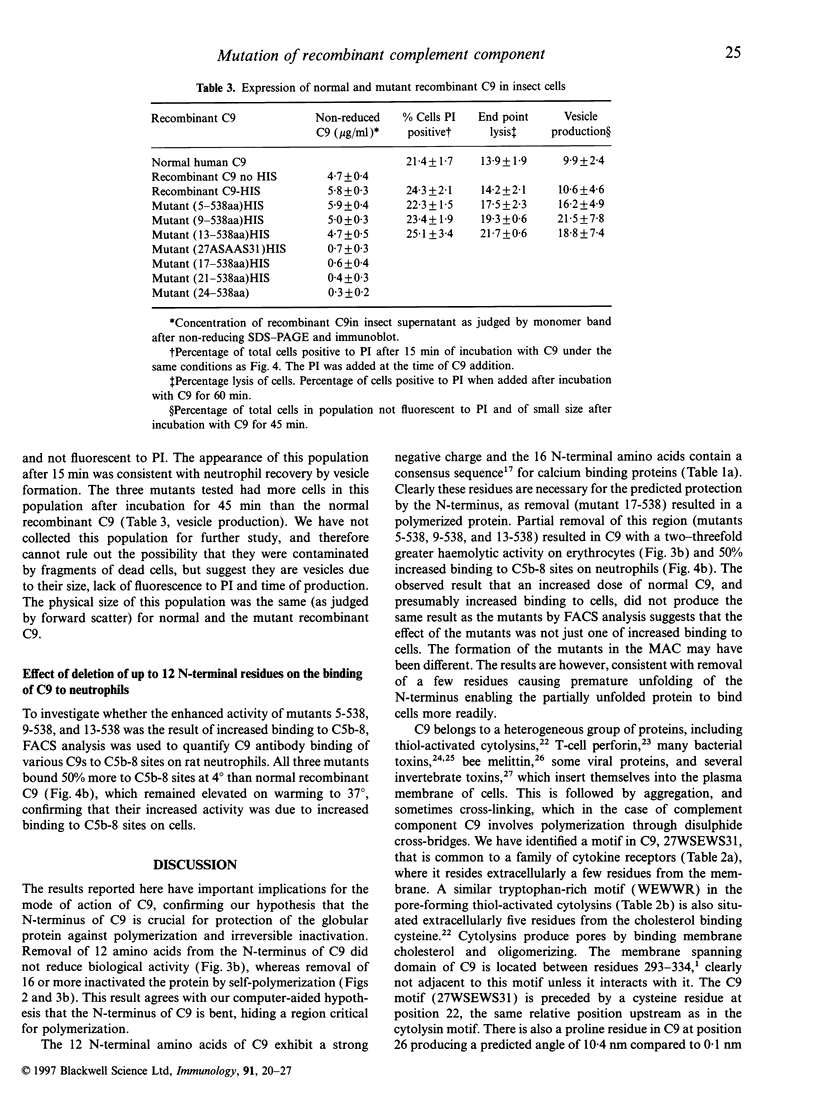
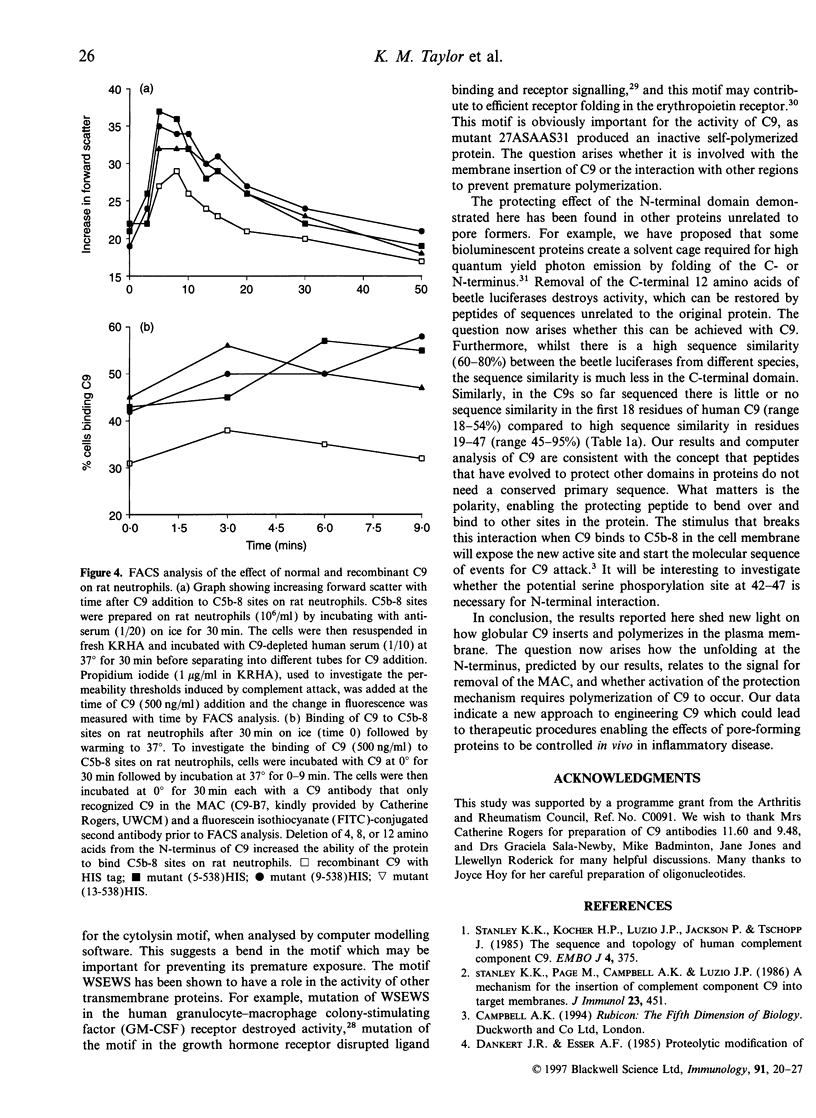
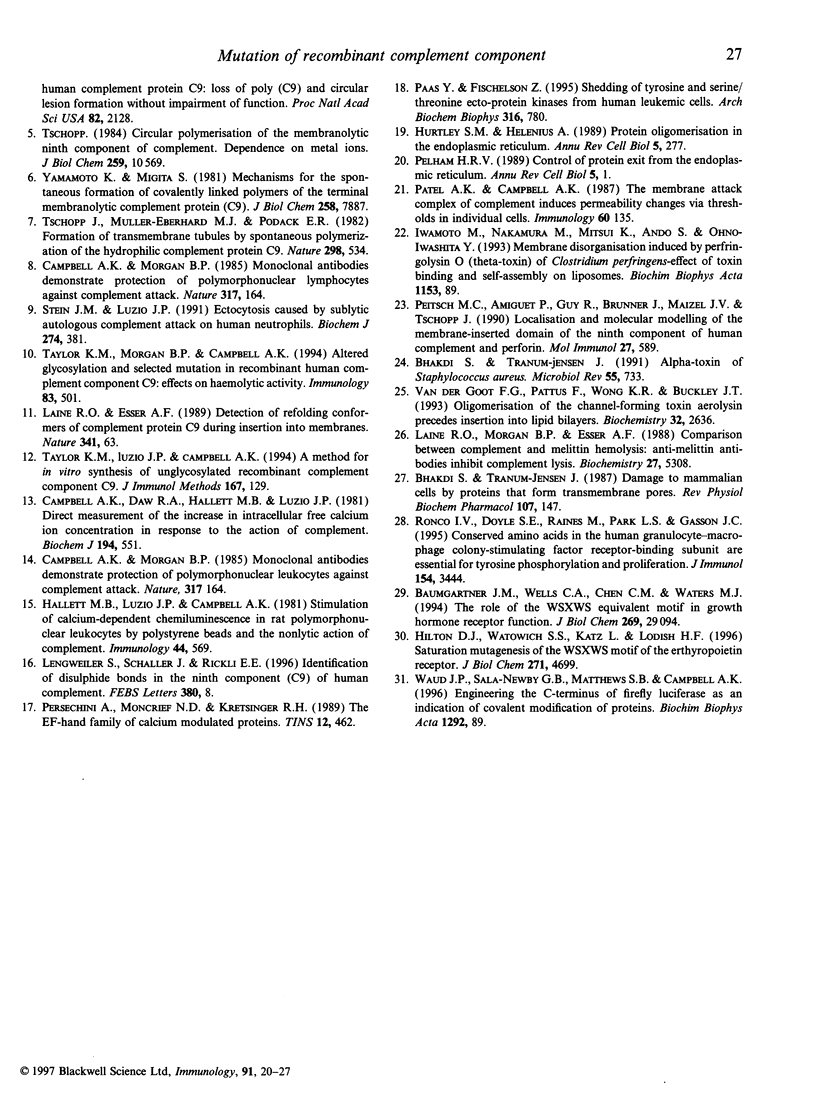
Images in this article
Selected References
These references are in PubMed. This may not be the complete list of references from this article.
- Bhakdi S., Tranum-Jensen J. Alpha-toxin of Staphylococcus aureus. Microbiol Rev. 1991 Dec;55(4):733–751. doi: 10.1128/mr.55.4.733-751.1991. [DOI] [PMC free article] [PubMed] [Google Scholar]
- Bhakdi S., Tranum-Jensen J. Damage to mammalian cells by proteins that form transmembrane pores. Rev Physiol Biochem Pharmacol. 1987;107:147–223. doi: 10.1007/BFb0027646. [DOI] [PubMed] [Google Scholar]
- Campbell A. K., Daw R. A., Hallett M. B., Luzio J. P. Direct measurement of the increase in intracellular free calcium ion concentration in response to the action of complement. Biochem J. 1981 Feb 15;194(2):551–560. doi: 10.1042/bj1940551. [DOI] [PMC free article] [PubMed] [Google Scholar]
- Campbell A. K., Morgan B. P. Monoclonal antibodies demonstrate protection of polymorphonuclear leukocytes against complement attack. Nature. 1985 Sep 12;317(6033):164–166. doi: 10.1038/317164a0. [DOI] [PubMed] [Google Scholar]
- Campbell A. K., Morgan B. P. Monoclonal antibodies demonstrate protection of polymorphonuclear leukocytes against complement attack. Nature. 1985 Sep 12;317(6033):164–166. doi: 10.1038/317164a0. [DOI] [PubMed] [Google Scholar]
- Hallett M. B., Luzio J. P., Campbell A. K. Stimulation of Ca2+-dependent chemiluminescence in rat polymorphonuclear leucocytes by polystyrene beads and the non-lytic action of complement. Immunology. 1981 Nov;44(3):569–576. [PMC free article] [PubMed] [Google Scholar]
- Hilton D. J., Watowich S. S., Katz L., Lodish H. F. Saturation mutagenesis of the WSXWS motif of the erythropoietin receptor. J Biol Chem. 1996 Mar 1;271(9):4699–4708. doi: 10.1074/jbc.271.9.4699. [DOI] [PubMed] [Google Scholar]
- Hurtley S. M., Helenius A. Protein oligomerization in the endoplasmic reticulum. Annu Rev Cell Biol. 1989;5:277–307. doi: 10.1146/annurev.cb.05.110189.001425. [DOI] [PubMed] [Google Scholar]
- Laine R. O., Morgan B. P., Esser A. F. Comparison between complement and melittin hemolysis: anti-melittin antibodies inhibit complement lysis. Biochemistry. 1988 Jul 12;27(14):5308–5314. doi: 10.1021/bi00414a054. [DOI] [PubMed] [Google Scholar]
- Paas Y., Fishelson Z. Shedding of tyrosine and serine/threonine ecto-protein kinases from human leukemic cells. Arch Biochem Biophys. 1995 Feb 1;316(2):780–788. doi: 10.1006/abbi.1995.1104. [DOI] [PubMed] [Google Scholar]
- Patel A. K., Campbell A. K. The membrane attack complex of complement induces permeability changes via thresholds in individual cells. Immunology. 1987 Jan;60(1):135–140. [PMC free article] [PubMed] [Google Scholar]
- Peitsch M. C., Amiguet P., Guy R., Brunner J., Maizel J. V., Jr, Tschopp J. Localization and molecular modelling of the membrane-inserted domain of the ninth component of human complement and perforin. Mol Immunol. 1990 Jul;27(7):589–602. doi: 10.1016/0161-5890(90)90001-g. [DOI] [PubMed] [Google Scholar]
- Pelham H. R. Control of protein exit from the endoplasmic reticulum. Annu Rev Cell Biol. 1989;5:1–23. doi: 10.1146/annurev.cb.05.110189.000245. [DOI] [PubMed] [Google Scholar]
- Persechini A., Moncrief N. D., Kretsinger R. H. The EF-hand family of calcium-modulated proteins. Trends Neurosci. 1989 Nov;12(11):462–467. doi: 10.1016/0166-2236(89)90097-0. [DOI] [PubMed] [Google Scholar]
- Ronco L. V., Doyle S. E., Raines M., Park L. S., Gasson J. C. Conserved amino acids in the human granulocyte-macrophage colony-stimulating factor receptor-binding subunit essential for tyrosine phosphorylation and proliferation. J Immunol. 1995 Apr 1;154(7):3444–3453. [PubMed] [Google Scholar]
- Stanley K. K., Kocher H. P., Luzio J. P., Jackson P., Tschopp J. The sequence and topology of human complement component C9. EMBO J. 1985 Feb;4(2):375–382. doi: 10.1002/j.1460-2075.1985.tb03639.x. [DOI] [PMC free article] [PubMed] [Google Scholar]
- Stanley K. K., Page M., Campbell A. K., Luzio J. P. A mechanism for the insertion of complement component C9 into target membranes. Mol Immunol. 1986 May;23(5):451–458. doi: 10.1016/0161-5890(86)90108-2. [DOI] [PubMed] [Google Scholar]
- Stein J. M., Luzio J. P. Ectocytosis caused by sublytic autologous complement attack on human neutrophils. The sorting of endogenous plasma-membrane proteins and lipids into shed vesicles. Biochem J. 1991 Mar 1;274(Pt 2):381–386. doi: 10.1042/bj2740381. [DOI] [PMC free article] [PubMed] [Google Scholar]
- Taylor K. M., Luzio J. P., Campbell A. K. A method for in vitro synthesis of unglycosylated recombinant complement component C9. J Immunol Methods. 1994 Jan 3;167(1-2):129–137. doi: 10.1016/0022-1759(94)90082-5. [DOI] [PubMed] [Google Scholar]
- Taylor K. M., Morgan B. P., Campbell A. K. Altered glycosylation and selected mutation in recombinant human complement component C9: effects on haemolytic activity. Immunology. 1994 Nov;83(3):501–506. [PMC free article] [PubMed] [Google Scholar]
- Tschopp J., Müller-Eberhard H. J., Podack E. R. Formation of transmembrane tubules by spontaneous polymerization of the hydrophilic complement protein C9. Nature. 1982 Aug 5;298(5874):534–538. doi: 10.1038/298534a0. [DOI] [PubMed] [Google Scholar]
- Waud J. P., Sala-Newby G. B., Matthews S. B., Campbell A. K. Engineering the C-terminus of firefly luciferase as an indicator of covalent modification of proteins. Biochim Biophys Acta. 1996 Jan 4;1292(1):89–98. doi: 10.1016/0167-4838(95)00199-9. [DOI] [PubMed] [Google Scholar]
- Yamamoto K., Migita S. Mechanisms for the spontaneous formation of covalently linked polymers of the terminal membranolytic complement protein (C9). J Biol Chem. 1983 Jul 10;258(13):7887–7889. [PubMed] [Google Scholar]
- van der Goot F. G., Pattus F., Wong K. R., Buckley J. T. Oligomerization of the channel-forming toxin aerolysin precedes insertion into lipid bilayers. Biochemistry. 1993 Mar 16;32(10):2636–2642. doi: 10.1021/bi00061a023. [DOI] [PubMed] [Google Scholar]




